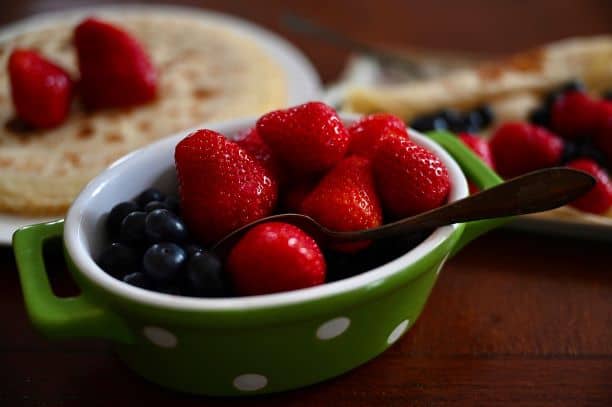Wondering how to eat plant-based at an all-inclusive resort? All-inclusive resorts are a great way to enjoy a relaxing vacation with less stress and more time for fun and relaxation.
There is usually an abundance of food to enjoy, which can make it easier to find plant-based choices. Whether staying at a beach all-inclusive or taking a cruise, check out these tips for having more fruits, vegetables, legumes, and whole grains.
I love that there is no need to interrupt your day to choose restaurants for each meal or worry about transportation back and forth, cost, tipping, or currency exchange rates. And it might cost a lot less at an all-inclusive resort (although some high-end ones are quite expensive).
However, with this convenience, there can be a tendency to eat too much or overdo it with alcohol.
This is from my experience at resorts in the Caribbean and Mexico (and cruises) and research, but I can’t speak for resorts in other parts of the world.
Table of Contents
Research Before You Go
Learn more about the food options to eat plant-based at an all-inclusive resort when choosing where to stay.
1. Look for online menus. These may be available for a la carte restaurants. They are often not available for buffet restaurants.
2. Check reviews on Trip Advisor, Google, and Facebook groups for your resort or area. People may have posted photos of foods they enjoyed and you can ask questions in Facebook groups. Look for YouTube videos too.
3. Call or send an email to the resort before booking to ask about any specific menu questions or food allergies.
4. Learn about meal options offered for excursions. I just declined one that sounded good except for a cold-cut sandwich with chips for lunch!
5. When you arrive, speak with guest relations, the maitre’d, or host(ess) and server. See if they have separate vegan or vegetarian menus and which items are acceptable to you. Knowing some key words and phrases in the language of the country you visit is helpful.
I just asked a cook if the refried beans were sin carne (without meat) – and I was glad I did because they were not!
Breakfast
At all-inclusive resorts, breakfast and lunch are usually served from buffets with beverages brought by servers.
Pros:
- There may be tons of choices
- You can check out how things look before trying them.
- You can select a replacement quickly if you didn’t like something.
- Usually, there is no wait to enter or get your food (exception: the Mongolian Grill on Carnival ships has taken an hour to have a stir-fry made in my experience). Although, sometimes there is a wait to find a clean table.
Cons:
- There could be cross-contamination with plant-based foods.
- Foods may not be labeled well and the ingredients may not be identified.
- The foods may not be freshly prepared.
- It is tempting to overeat.
- The food temperatures may not stay in a safe range.
- The items may be picked over.

For this reason, we much prefer eating in a dining room where we are served.
Here are some plant-based ideas for breakfast:
- Smoothie station
- Plant-based dairy: these may be out on the buffet, or you may need to request them. I find most places have almond milk and soy milk. Oat milk and plant-based yogurt do not seem to be available as often.
- Cereal: Boxed cereal will list the ingredients and you can use Google translate if you have service as needed. Check if prepared hot cereals contain milk
- Fruit: typically there will be many fresh tropical options
- Vegan menu or buffet area: possibly vegan eggs, cheese, breakfast sandwiches, sausage
- Yogurt toppings bar with nuts, seeds, berries, dried fruit, and granola
- Bagels or whole wheat toast with nut butter
- Chia pudding: check what kind of milk it is made with
Buffet Lunch and Dinners
Salads: look for edamame, chickpeas, cooked tofu, nuts, and a variety of vegetables and fruits. There may be flavored vinegar and oils, which can be a fresh alternative to premade salad dressings.
Cooked vegetables, legumes, rice, and potatoes.
Here is a video with an example of dishes such as beans, onions, cooked cabbage, peppers and onions, and lentils. A nice variety of options were offered at this steam table for every meal. Mushrooms, onions, lentils, and cooked soya were surprisingly good on a recent trip.
Video link ->Vegan foods on buffet
Pasta: There may be freshly made pasta with vegetable choices. Ask about the sauces available: tomato or olive oil are usually good options. Pesto sauce may contain cheese.
Burrito or grain bowl: Put together yourself from rice, quinoa, beans, or lentils and top with your favorite cooked veggies, salad bar items, nuts, guacamole, salsa, and/or lime juice.
I have not seen many alternative proteins such as tofu, tempeh, seitan, soy burgers, vegan eggs, vegan sausage and burgers, but this may be vary by the resort.
Baked stuffed potato or sweet potato.
Fried rice: See if this is made with or without eggs. Check if butter was used. If so, can they make a separate pan for you with oil? There may be separate vegetables or tofu to have with it.
Sorbet: This may be a good dessert option (plus it is naturally low in fat), but ask if the sugar in it is vegan if that is important to you.

Ala Carte Dinner Restaurants
Italian: Look for salads, grilled vegetables, and pasta dishes. Vegan cheese for pizza may not be available, but perhaps they can make pizzas without cheese.
Ovolactovegetarians may also find ravioli, tortellini, cream-based sauces, pizza, or vegetable lasagna.

Japanese: this kappa maki sushi roll was made with cucumber: you can request them without sriracha mayonnaise. Vegetable tempura may be fried in oil that animal foods are fried in. Stir-fried vegetable dishes with rice or noodles may be good options.

Mexican: tacos, burritos, tostadas, and empanadas can be made with veggies and beans.
Spanish: gazpacho (cold vegetable soup with cucumbers, tomatoes, onions, and garlic), look for vegan risotto and paella dishes. Patatas bravas: potatoes in tomato sauce. Churros that are not filled with cream are a fun dessert or snack option!
Steakhouse: look for salad bar items, a baked potato, and vegetable side dishes.
Indian: this cuisine is quite varied and vegetarian-friendly. Look for chickpea, eggplant, mung bean, and other vegetable dishes and rice.
Chutneys and pickles are often served alongside dishes. I love a mix of cucumbers, tomatoes, onion, and spicy peppers. Dal is made from red or yellow lentils. Some sauces contain yogurt or cream: be sure to ask. Naan (flat bread) may be made with yogurt.
Seafood: these restaurants can be tricky: sometimes a vegetable plate is the only option.
Alcohol Options

Wine: check the brands online to see if the wines served are vegan.
Mixed drinks: some may be made with fresh fruit juices. If they use a premade mix, sugar, or simple syrup, ask if the sugar is vegan if this is important to you.
And be sure to drink enough water. There can be a tendency to overdo it with alcohol when it is “free” – included in the hotel price. The National Institutes of Health recommends no more than one standard alcoholic drink per day for women and two for men.
I suggest not purchasing the unlimited drink package for cruises
Tips for Preventing Food Borne-Illness
Food-borne illnesses affect an estimated 600 million people each year, according to the World Health Organization, and traveler’s diarrhea affects an estimated 30 – 70% of travelers.
- Babies, children, immunocompromised people, and seniors are at a higher risk.
- Foods at a buffet could be contaminated with salmonella, campylobacter jejuni, e. coli, norovirus, or other pathogens (disease-causing microorganisms)
- Wash your hands before you eat. Look for hand sanitizer to use, although it is not as effecive as handwashing.
- Make sure hot food is hot and cold food is cold.
- Avoid uncooked or undercooked foods such as raw fish in sushi, rare meats, and unpasteurized cheeses.
- If you use tongs or a spoon to load food onto your plate, don’t touch foods you are going to eat, like a roll, with that hand.
- Watch out for eateries without walls: flies and birds may be present and transmit illnesses. It is also harder to keep the cold food cold.
- Check before you travel for onsite or nearby physicians, pharmacies, and hospitals. Consider travel insurance. See if you can contact your or another doctor via the patient portal or a telehealth app.
- Talk with your physician when planning international travel to see if vaccines are required or recommended and other recommendations they have to stay well. Ask what over-the-counter medications would be helpful to bring.
Traveler’s Diarrhea
- This may be from local bacteria (most common), viruses, parasites, or a foodborne illness.
- Many resorts are in an area where bottled water is advised. If so, check if the ice cubes are safe, and stock up on bottled water for your room and brushing your teeth. Another good reason to have extra water is in case of a storm and any interruption in service.
- See if your resort washes incoming produce with a sanitizing solution. Avoiding salads and cut fruits / raw vegetables may be recommended for some locations.
- Learn more from this article about Traveler’s Diarrhea from the Cleveland Clinic.
More Plant-Based Eating Travel Tips
- Healthy Eating at Indoor Water Parks
- Top 10 Vegetarian and Vegan Cruise Food Hacks
- 21 Healthy Beach Snack Ideas
- Healthy Snacks on Your Summer Road Trip
- How to Enjoy Healthy Eating on Cruises
- Healthy Choices from Free Breakfasts at Hotels
Please share in the comments if you tried any of these tips for plant-based eating at all-inclusive resorts and how they worked for you!
Updated 8/4/25. Originally published: 7/11/24.
Don’t miss a recipe! Sign up here for my free bi-monthly newsletter.








A well-structured guide for enjoying plant-based dining at all-inclusive resorts. The suggestions make it easier for travelers to maintain dietary preferences while exploring new destinations.